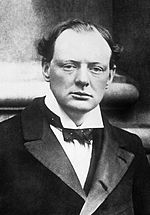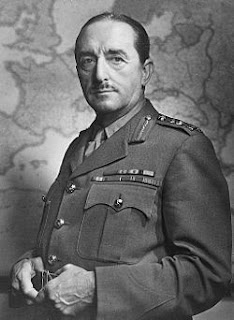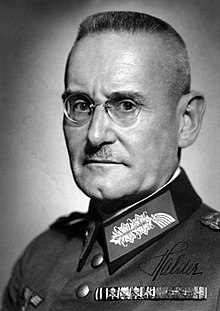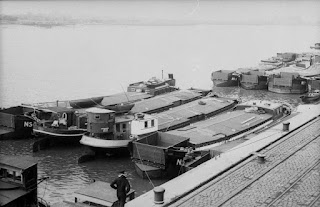World War II is a folk memory that looms large in the British psyche. Too large it might be said. In popular culture it’s usually been a portrait of plucky little Britain standing alone facing a powerful Nazi-dominated Europe. A nostalgic and consoling narrative that’s simple for people to understand. It’s seen, says historian David Edgerton, as “a uniquely powerful moment of national success”. For many people it embodies something about the character of being British and has unfortunately infused the Brexit dispute, the noises growing ever more shrill as this looming disaster came closer.
Yet the story is laden with myths. Few of those now
alive will remember the summer of 1940, as they would need to be in their mid-80s
or older. Even fewer would have heard Churchill’s speeches, given in Parliament,
and not broadcast. Throughout history Britain never beat continental
adversaries - Louis XIV, Napoleon or Hitler - on its own. It always had strong
European and later imperial allies. The huge distortion of the truth, as ignorant as it is arrogant, is a
recent myth. It seems particularly beloved of the 50-70 age group. No-one at the time would
have believed it.
Nostalgia and international co-operation
Such nostalgia might make more sense if it recognised that
post-war successes were largely achieved with other nations. World War II was
such a calamity that by 1944 the need for global change was obvious. At Bretton
Woods, Britain was a main driver behind the International Monetary Fund and
World Bank, formed to promote prosperity, and peace, to prevent the economic
shocks that had led to war in the first place. GATT, as a trade body to reduce
tariffs was also created. The United Nations dates from 1945 - the Allies
fought under that name later in the war. Britain was/is a permanent Security
Council member.
The bodies underpinning British national security were almost all formed in the period during or just after World War II. They include NATO, GCHQ and Anglo-American nuclear co-operation. The Five Eyes intelligence sharing operation also dates from the period. These were instigated in an atmosphere not of myth and fantasy but of the reality of what had happened. They have all stood the test of time.
With the defeat of Germany in May 1945 came the de
facto partition of Europe. There emerged two antagonistic political, social,
economic and military blocs. Each - Communist and non-Communist, divided by the
‘iron curtain’ - was tied to the power that had liberated it from German
occupation. But a severe economic crisis engulfed both the Continent and the
British Isles in the early post-war years. The story of how both continental
Europe and Britain separately recovered is really the story of much of the post
war period. Was Britain’s trans-Atlantic ‘special relationship’ or its
trans-Channel connection more important? It was an open question and for some people remains so
to this day.
Economic problems
The British economy had been on a war footing when the country had successfully mobilised economically as well as militarily. Indeed in doing so it was the most efficient nation of all the belligerents. By 1941 GDP was 21% higher than in 1938. Edgerton has stressed the success story in producing munitions at home and using supplies from the Empire and the US to build a high quality stock of weapons. Industrial production was quickly re-oriented towards munitions, and output soared. So, for example, Fighter Command emerged from the Battle of Britain with more aircraft than it had at the start.
Logo of the Marshall PlanBut the economic costs were enormous. During the war there was a net inflow to Britain of £10bn. £1.1bn of this came from selling investments, £3.5bn from new borrowing and £5.4bn from the US via Lend-Lease, which from 1941 supplied material and munitions worth $31bn. This did not have to be paid for but when Lend-Lease was terminated in August 1945 Britain had lost two-thirds of its pre-war export trade, crucial to servicing its war debts, and could not pay for essential US supplies. Canada had lent on easy terms and India, too, was owed money via the sterling bloc. But gold and currency reserves were exhausted. The bulk of overseas assets had been sold to fund the war effort.
So at the end of the struggle Britain was basically bankrupt.
It was forced to obtain $4.3bn in loans from the US in December 1945 - only
finally repaid in 2006. Exports had to be prioritised and were boosted to service the debt, so rationing was
maintained to this end. Europe, meanwhile, formed a Coal and Steel Community, and then a Common Market, the European Economic Community. Britain stood aside and missed that boat.
World power pretensions
In 1947 the far-sighted US Marshall Plan pumped aid
into Europe. Britain didn’t use its $2.7bn to rebuild infrastructure and
modernise industry like Italy and Germany. 97% of Britain’s Marshall Aid was
used to service debts. Railways, roads and telecoms remained backward and
rationing only ended in 1954. Britain took defence seriously and funded it properly,
but a series of governments squandered money supporting world power pretensions,
keeping open far-flung military bases. This contributed to jeopardising Britain’s
economic future.
The Labour government under Attlee from 1945-51 embarked on bold initiatives from
the wartime Beveridge Report and 1944 Education Act - a welfare state, national
health service and educational reform. These plans were largely agreed across the political spectrum. They were funded mainly from
taxation. A huge home building programme followed to rehouse victims of bombing
and replace slums not already destroyed by the Luftwaffe. And defence costs took up to 20% of the national budget. Yet Britain’s debt to
GDP ratio fell from 270% at the peak to some 40%. Orthodox economics, perhaps,
but austerity writ large.
'All in it together'?
For Britain the ‘people’s war’ raised democratic hopes
and promised a better country in future. Wartime planning had generally worked and was mainly
accepted in peacetime. The organisation and control that won the war continued
afterwards. But wartime myths grew. Historians later debunked the ‘all pulling
together’ idea - crime rose, the black market flourished and bombed homes were
looted. Strikes were frequent. And you could be off ration at a price in some
classy London hotels.
It's worth a look back to the end of the war. In 1945 Britain had Europe at its feet. On the 'right side of history' its reputation was justly high and its prestige unmatched. But successive governments, and the population, could not ‘unthink’ an imperial global past. The chance for a leading European political and economic role was lost. In 1950 UK output per head was still 30% above the average of the six founding European Economic Community members. 20 years later it had been overtaken by most of Western Europe. Britain finally joined the EEC in 1973.
Prolonging the myths
A recent book by Duncan Weldon, 200 Years of Muddling Through, neatly summarises Britain's economic history - and the politics that drove it - from the defeat of Napoleon. It makes sober reading. It concentrates on finance and highlights some national successes but also the endless mistakes and opportunities lost. These days there's no political consensus at all about this so it's become the stuff of polarised 'culture wars'.




























